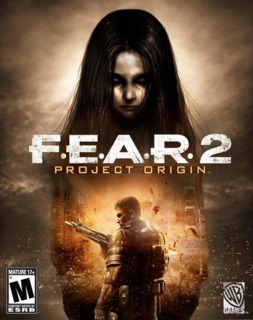Blood is dripping from the ceiling, and blood is plastered on the walls. Blood credibly spills from butchered enemies, and bloody corpses and body parts are spread all-over around.
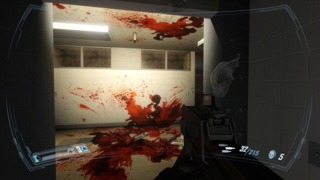
Enemies are lurking everywhere, all at once ATC and Replica forces, ghostly shifters, and mutated specimens. From time to time the first-person vision gets blurry to let a translucent female character be discerned, yet she is seemingly not as deadly an appearance for our playable protagonist, Sgt. Michael Becket, operator of the same Delta Force squad that interfered at the end of the first game.
F.E.A.R. 2: Project Origin has all it needs for a psycho-horror action game; but in addition to good graphics, reliable gameplay mechanics, and an advanced enemy AI, it has something refreshingly "old-school" due to the scant, suggestive storytelling and rare music and sound effects that adequately color individual action-filled moments without taking over all the action.
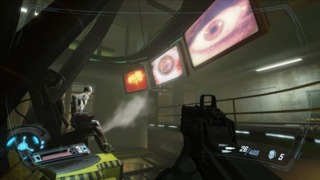
No radar shows the numerous enemies' whereabouts, no arrows signal us where to go next, and health doesn't recover automatically, though the difficulty is well-dosed when playing on "normal", and no walkthrough is necessary, either. Dispatched enemies drop weapons, ammo, and occasionally health, and med and armor kits can locally be picked up, so we just have to worry about regularly replenishing health and ammo for weapons that get more powerful along the different chapters but cannot be upgraded.
The story itself continues where the first F.E.A.R. (First Encounter Assault Recon) ended: Upon saving the yet familiar Genevieve Aristide, under attack by a Security Ops team sent by the very Armacham Technology Corporation she presides, Sgt. Becket learns from "Project Harbinger", successor to Project Origin, attempting to design psychic commanders similar to prototype Paxton Fettel (who in the 1st game commanded an army of telepathically controlled clone soldiers) and for which both Becket and his mate Keegan are considered promising subjects such as the earlier “Point Man”.
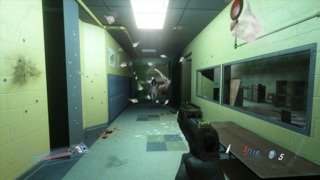
A big explosion follows , and when regaining consciousness, Becket has been operated and even psychically altered in the "attunement chamber" the same Aristide tricked him into. He now gets attacked more closely by Alma, the heinous female ghost, and a man calling himself "Snake Fist" reveals over his radio that attracted by Becket's psychic signal she is trying to "consume" him, scenting him like "free pizza at an anime convention".
We also learn that Alma's father Harlan Wade stuck her in a suspension tank in an induced coma when she was eight years old; it was only the birth of the first prototype that woke her up, at age 15, and a second time a year later. Realizing she was influencing the 2nd prototype's actions even while unconscious and locked away in an isolated tank, they turned off Alma's life support and left her to drown in its amniotic fluid, but Alma's psychic signature still prevailed beyond her technical death.
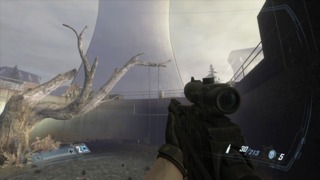
Wade Elementary where Snake Fist and Aristide are hiding is a now ATC Security-controlled school whose basement houses one more paranormal project called "Paragon". Finding Snake Fist seems vital, but Becket first has to take out Colonel Vanek who wants to bury him "along with the rest of this unnatural fuckery". Luckily "Snake" aka Terry Halford, an ATC researcher, lives just long enough to explain how to defeat evil Alma: by means of the telesthetic amplifier located in yet another Armacham facility, inside an old nuclear reactor on the nearby Still Island.
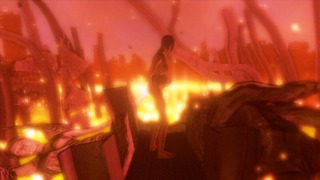
Yet instead of using his amped psychic powers against Alma's, Becket gets sealed together with her inside the device. Whether fruit of Aristide's self-serving calculations or of Becket's psychogenic hallucinations, in the end Alma appears, amidst a radioactively devastated landscape, pregnant with a new prototype: "We make our own monsters. And they come back to haunt us."
Project Origin's solid gameplay adds iron sight aiming, a dynamic cover system, and Powered armor to the core mechanics known from the first game, including slo-mo "reflex time" during combat and an advanced AI that lets notably human enemies act "as a team" while using the scenery blind-firing and cover-takingly to their advantage. The bullet time simulating superhuman reflexes by slowing down the environment's time for us to shoot at normal speed is just one of F.E.A.R. 2's striking visual effects favoring reflection, distortion, and inverted colors.
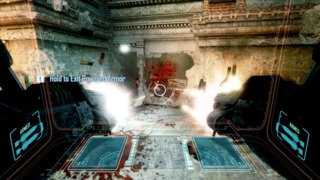
Using the powered metal mech to blast through the ghost town-like ruins peopled with both ATC and Replica forces is thus satisfying through both its deadly and visual impact, and the crumbling façades are pictorially scattered with red stains. However impressive the environmental destruction, the debris city section gives even stronger the feel of first-person shooting than of first-hand scare, which is sensible above all in the genre-generic dark corridors and basement corners of Wade Elementary filled with elusive quantum foes and crazed mutants.
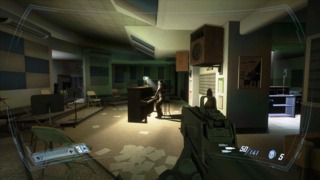
It is the clair-obscures of those closed structures that brings F.E.A.R. 2 back to its origins as psychological horror game characterized by enigmatic encounters—human, sub-human, superhuman entities that all at some moment aim to disembody our protagonist who continues unimpressed his mission through realistic classrooms, concrete basements, and futuristic labs. It is also the one or the other detail in the game's design—children drawings, a ghostly pianist, lifelike rats (that can be shot), the rifle's crystal scope—that gives it an extra appeal beyond the purely functional of its structures.
You'll likely have played scarier games, and the sequel might not be as outstanding as the first entry in the F.E.A.R. series, but its uneasy atmosphere and mysterious story, the solid shooter mechanics, and the stylized effects are what make Project Origin a game still gratifying to be played six years after its release.
